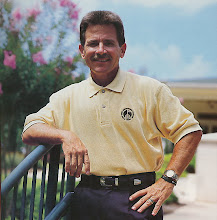These 25 baskets are filled with thousands of balls a day. This equates to thousands of divots per day. Each baskets hold hundreds of ball and the baskets are re-filled numerous times per day.
Below is how the range looks at the end of the day. You can see how much of the turf has been removed. New seed will germinate and begin to grow in just a few weeks but it takes months for theses areas to become dense and mature.
When balls are spread out over the practice area, as in the photo on the right, this uses the most turf space. When golfers hit balls from a solid area, as shown in the left side of the photo, this takes the longest for the area to fully recover.
Therefore the linear ball placement, as located in the center of the photo, disturbs the least amount of turf and contributes to the quickest grow in and recovery of the turf.
Random or scattered hitting of balls uses the most teeing surface and should be avoided. A scattered divot pattern removes the most amount of turf because a full divot is removed with every swing. Scattering divots results in the most turf loss and uses up the largest area of a tee stall. This forces the golf facility to rotate tee stalls most frequently and often results in an inefficient use of the tee. .
When large areas of turf are displaced by hitting in a concentrated location, this area will take months to re-establish and mature. A concentrated divot pattern removes all turf in a given area. While this approach does not necessarily result in a full-sized divot removed with every swing, by creating a large void in the turf canopy there is little opportunity for timely turf recovery.
The linear ball placement method uses the least amount of turf and recovers the quickest. This is the recommended ball placement patter for practice. The linear divot pattern involves placing each shot directly behind the previous divot. In so doing, a linear pattern is created and only a small amount of turf is removed with each swing. This can usually be done for 15 to 20 shots before moving sideways to create a new line of divots. So long as a minimum of 4 inches of live turf is preserved between strips of divots, the turf will recover quickly. Because this divot pattern removes the least amount of turf and promotes quick recovery, it is the preferred method.
Each afternoon the staff distributes new seed and soil to the current day's divots. It can take the seed several weeks to germinate and then months to mature to an acceptable stage for usage. The photo below shows newly germinated grass seed out on the course (not on the range.) This turf is about 4 weeks old. You can see it is several inches tall but still very thin. It has not had the chance to "tiller" and spread and densen to the point where it will support a ball on top of it.
The photo below is of the same turf at two months of age. It is still not dense enough to support driving range usage.
It will take virtually a full growing season for the driving range seed to germinate and mature to the point of being ready to hit off of. When we go from front to back 3 to 4 times a summer, you can see that the turf simply cannot grow fast enough to mature to keep up with the activity and volume of hitting on the range tee. Therefore the more precisely we practice both in the number of balls we hit and the pattern in which we place the balls, the more we enhance the recovery period for the turf.














No comments:
Post a Comment